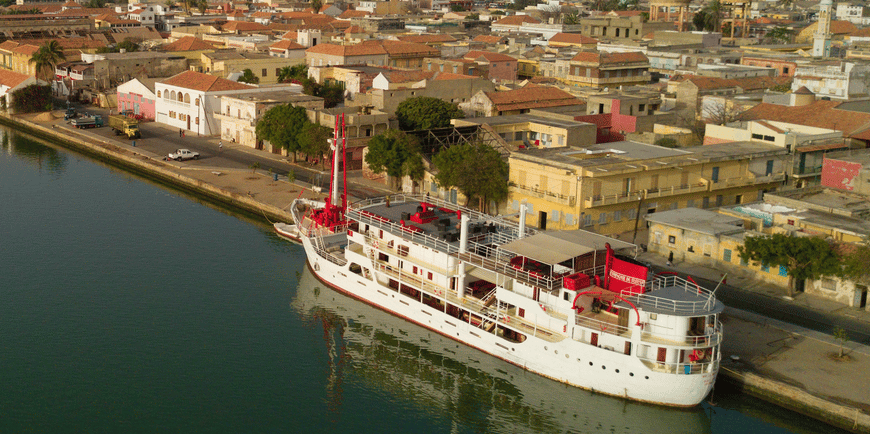Rising sea levels and coastal erosion in Saint-Louis, Senegal: a threat to populations and territorial sovereignty
AFRICA
Thomas Dos Remedios
9/14/20257 min read


A HISTORIC CITY AT THE HEART OF COASTAL VULNERABILITY
Saint-Louis, Senegal occupies a unique place in the history and geography of West Africa. Founded in the 17th century on an island in the Senegal River, it was the first lasting French colonial settlement in the region and became successively the capital of Senegal and then of French West Africa. Its architecture, bridges and cultural life earned it a place on UNESCO's World Heritage List in 2000. However, this rich heritage depends on an extremely fragile natural balance. The city is located on a narrow sandy strip called the ‘Langue de Barbarie’, which separates the river from the Atlantic Ocean. This area, constantly reshaped by river and sea dynamics, forms a precarious barrier against the onslaught of waves and floods.
However, for several decades now, this fragile balance has been disrupted by the combination of two phenomena: global climate change and local human intervention. The Intergovernmental Panel on Climate Change (IPCC) indicates that average sea levels could rise by 43 to 84 centimetres by the end of the century, depending on emission scenarios. For Saint-Louis, where the level has already risen by about three millimetres per year since the 1990s, such a projection would amount to an existential threat. This global trend is compounded by aggravating local factors: in 2003, to prevent urban flooding linked to river flooding, the authorities ordered the opening of an artificial breach in the Langue de Barbarie. Initially barely 4 metres wide, it widened to more than 800 metres in a few months and continues to expand. This passage has profoundly altered the currents, accelerating coastal erosion and the salinisation of inland waters. The intervention, intended to protect the city, has paradoxically increased its vulnerability to the ocean.
AN ONGOING HUMAN DISASTER
The inhabitants of Saint-Louis now live in constant precariousness as they face the onslaught of the sea. The densely populated neighbourhood of Guet Ndar, emblematic of Senegalese artisanal fishing, is the most striking symbol of this. Hundreds of colourful pirogues dock there every day, carrying out an activity that accounts for nearly 20% of Senegal's gross domestic product and provides more than half of the animal protein consumed in the country. But this vital sector is under threat. The beaches where the boats are pulled ashore are gradually disappearing, and houses built along the coastline regularly collapse under the pressure of the waves.
The figures illustrate the scale of the crisis. According to Senegal's National Climate Change Adaptation Action Plan (PANA-Senegal), more than 150,000 people could be displaced in the medium term in the Saint-Louis region, equivalent to the entire population of the island city. Families have already been forced to leave their destroyed homes, often to move to precarious relocation sites inland, such as Khar Yalla. These makeshift camps lack drinking water, sanitation and basic infrastructure, leading to poor living conditions and fuelling a sense of abandonment. Nevertheless, many residents refuse to leave their threatened homes, out of attachment to the coast and because of its proximity to their fishing activities. This resistance increases their vulnerability: some live in cracked and weakened buildings, exposed to even the slightest storms.
The impacts of rising water levels are not limited to housing. Agricultural land on the outskirts of Saint-Louis is also affected by salinisation, a direct consequence of the breach and marine intrusion. Rice fields and vegetable crops, which depend on the river for irrigation, are seeing their yields decline. This food insecurity is compounded by the loss of fishing income, exacerbating socio-economic precariousness. Thus, the ongoing ecological disaster is accompanied by a silent humanitarian crisis, whose first victims are the poorest local communities that are most dependent on natural resources.
EROSION OF TERRITORY AND SOVEREIGNTY
The erosion of Saint-Louis not only threatens its inhabitants: it poses a problem of territorial integrity and, by extension, national sovereignty. Every piece of land swallowed up by the Atlantic Ocean equates to a physical reduction in Senegalese territory. While this loss does not immediately affect international borders, it weakens the state's ability to fully exercise its authority over certain strategic areas. Erosion does not just swallow up houses: it also erases essential infrastructure such as roads, schools and fishing landing sites.
The issue takes on a geopolitical dimension when one considers the economic importance of Saint-Louis and its region. The Senegal River valley is one of the country's main agricultural areas, particularly for irrigated rice cultivation, which is central to food security policies. The loss of productive land compromises ambitions for self-sufficiency and increases dependence on imports. In addition, coastal erosion threatens offshore gas exploitation projects in Senegalese and Mauritanian waters, notably the gigantic Greater Tortue Ahmeyim field, operated by BP and Kosmos Energy. Access to and exploitation of these strategic resources could be hampered if the coastal support infrastructure were to be affected by rising sea levels.
Within the country, forced displacement creates new challenges. Relocating tens of thousands of people requires finding available land, building housing and providing alternative means of subsistence. However, these operations, often carried out in a hurry, generate land conflicts and exacerbate social tensions. The Senegalese government therefore faces a double pressure: on the one hand, protecting its citizens from a natural phenomenon amplified by climate change; on the other, preserving social cohesion and political stability threatened by internal migration and growing inequalities. Sovereignty is no longer measured solely by the demarcation of borders, but also by the state's ability to protect its citizens and resources from an invisible enemy: rising sea levels.
LIMITED RESPONSES TO THE SCALE OF THE PHENOMENON
For several years, the Senegalese authorities, with the support of the international community, have stepped up initiatives to respond to the crisis in Saint-Louis. In 2018, the Green Climate Fund granted Senegal $10 million to support a programme to relocate exposed populations. The government-led ‘Saint-Louis Emergent’ project plans to move several thousand families out of the most threatened area and redevelop the coastal areas. Protective dykes have been built, particularly in the Goxu Mbacc area, in an attempt to contain the ocean's onslaught. In addition, projects to replenish the sand and rebuild the Langue de Barbarie are being studied in order to restore part of the natural barrier that once protected the city.
However, these measures face several limitations. First, the funding available remains derisory given the scale of the needs. Relocating tens of thousands of people, building resilient infrastructure and protecting coastlines would require hundreds of millions of dollars. Second, the technical solutions implemented quickly reveal their limitations. Dykes, for example, protect certain neighbourhoods but sometimes exacerbate erosion in adjacent areas by altering sea currents. In addition, these infrastructures are often damaged after a few years due to a lack of regular maintenance. Finally, relocation projects come up against the cultural and economic attachment of inhabitants to their territory. Fishermen, in particular, refuse to move away from the sea, making forced displacement difficult and socially costly.
This situation illustrates the dilemma of climate change adaptation policies in developing countries. Between emergency solutions financed by international donors and long-term strategies that are still in their infancy, public action is struggling to keep pace with the phenomenon. Saint-Louis thus embodies the structural vulnerability of a country which, despite strong political will, remains dependent on external aid and limited by insufficient financial and institutional resources.
SAINT-LOUIS, A SYMBOL FOR ALL OF COASTAL AFRICA
The case of Saint-Louis extends far beyond Senegal's borders. It illustrates a problem common to many African cities exposed to rising sea levels. According to the World Bank, more than 40% of the continent's population lives in coastal areas, including several rapidly expanding megacities. Lagos in Nigeria, Dar es Salaam in Tanzania, Alexandria in Egypt and Cape Town in South Africa are among the cities identified as particularly vulnerable. If no radical measures are taken, several million people could be displaced over the coming decades, creating unprecedented numbers of ‘climate refugees’.
Saint-Louis also symbolises the paradox of climate change in Africa. The continent is the lowest emitter of greenhouse gases globally, but it is already suffering the most severe consequences. This climate injustice fuels strong political discourse, led by Senegal and other African states in international negotiations. The situation in Saint-Louis is regularly cited at United Nations climate conferences (COP) as an example of the urgent need to finance adaptation in Southern countries. Thus, beyond the human and heritage tragedy, Saint-Louis has become a testing ground for the future of African coastal societies. Its fate foreshadows that of many other cities: either they manage to anticipate and adapt thanks to ambitious protection policies, or they will suffer an inexorable decline in the face of the ocean. Saint-Louis is therefore both an ongoing tragedy and a warning to the whole of Africa and the world.
SAINT-LOUIS IN 2050
Imagining Saint-Louis in 2050 means projecting ourselves into an uncertain future, marked by climate change, local political choices and the international community's ability to support the most vulnerable countries. Two opposing trajectories are emerging: that of a submerged and abandoned city, or that of a territory that has become a laboratory for climate resilience.
In a pessimistic scenario, the absence of ambitious measures and the continuation of current trends would lead to the partial submersion of the city. IPCC projections predict a sea level rise of between 30 and 50 centimetres in West Africa by 2050. For Saint-Louis, where the average altitude does not exceed two metres, this would mean chronic flooding of entire neighbourhoods, notably Guet Ndar and the Langue de Barbarie. The breach that opened in 2003 would continue to widen, accentuating erosion and making any natural restoration illusory. Tens of thousands of people would be forcibly displaced: fishing families, deprived of their homes and livelihoods, would find themselves relocated to precarious camps, far from the sea that shapes their identity. The city, deprived of its economic and cultural vitality, would then risk becoming a partially abandoned space, reducing its historical heritage to a few symbolic islands, isolated by the waters.
But an optimistic scenario remains possible. If Senegal, supported by its partners, manages to mobilise sufficient resources, Saint-Louis could become a global showcase for climate adaptation. Heavy infrastructure, such as modern dykes, the artificial reconstruction of the Langue de Barbarie and the creation of vegetation belts to stabilise the coastline, would protect the city from the onslaught of the ocean. At the same time, planned relocation programmes would offer residents decent housing and alternative activities, ensuring a smooth social transition. The local economy would diversify: heritage tourism, focused on colonial architecture and river history, would become a major resource, while the exploitation of offshore gas fields would partially finance the investments needed for adaptation. Instead of disappearing, Saint-Louis could thus become a symbol of resilience and an example studied internationally.
The future of Saint Louis in 2050 therefore depends not only on natural dynamics, but above all on human decisions. Its fate will be decided in the coming years: either a slow agony in the face of rising waters, or a rebirth driven by collective action. In one case, the city would embody the world's failure to protect vulnerable societies in the South. In the other, it would become a global capital of adaptation, demonstrating that political will and international solidarity can push back the boundaries of climate fatalism.
Thomas Dos Remedios, for SPECTIO
The statements made are solely those of their authors and do not reflect the position of the Think Tank Spectio.
